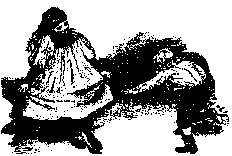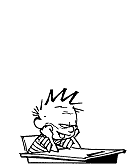ESE548 : The Class : Learning Style | ||||||
 Evaluate Your Learning Style
Evaluate Your Learning Style
There are many ways to learn. Most of us have a preferred style and utilize
a wide range of tools and ways of thinking about content.
As you take this course, you will have an opportunity to learn vital facts and ideas about the students you may someday teach. Each module will provide insights into the lives of students, their learning abilities and disabilities, their families. You will also learn about the importance of individualizing instruction for children. Not only is it vital to care for youth in the most responsible and respectful manner - you will learn that it is mandated by law. IDEA '97* provides directives and funding to support educators in the quest to recognize and ultimately meet individual needs for youth with disabilities.
For some of you taking this course, the information will be contrary to your own school experiences. Many students are almost invisible during school. In some classes, student are given identical learning experiences. They have the same reading assignments from identical books. They hear the same lectures, take notes and do the same homework assignments. They sit quietly in seats, and take identical exams. This is true even if the material is new to students, easy to learn or extremely demanding and difficult.
Part of this course asks you to think about the pedagogy of teaching - what is good teaching, how do children learn, and how do teachers get ideas across? What constitutes great teaching? . . . and then, how can a teacher reach all the students? Schools often use a "one size fits all" approach to teaching and learning. Has it been effective for you? Are there things you believe teachers could do to improve? Did you ever wish you could go at your own speed? Feel like you studied hard but a test asked the wrong questions?
You will have an opportunity to think about some of those questions and look at some of the pieces to the learning puzzle.

There are many things that affect learning - time of day, temperature in the room, whether a student feels comfortable, is going at an easy pace or day dreaming. We know some students learn best when the material is presented orally, some learn better when allowed to read and absorb alone.
Students who are social want to talk about each idea with others. Some want supports and proofs to validate the material, others want to spend time assimilating ideas into a personal paradigm. Some students want to take time to make mind pictures, argue about personal feelings about the material with others,

and some are not ready to learn certain materials and get upset
or shut down constructive thinking
when the challenges feel overwhelming.

These factors are sometimes referred to as learning styles. Some research supports the idea that each of us has a preferred style of learning. Of course, most of us learn many ways, and lots of things impinge on our ability to construct meaning. Some of us may even have a different learning style for exploring math and choose a singular set of different and equally functional skills when reading. Some of us may learn best in the morning, or find certain subjects so appealing that we become immersed in them while others repel us, somehow.
Part of the purpose of this course is to help you explore learning. For
a research article on learning styles, visit this web location. [This
location discusses research on learning styles] http://www.geocities.com/~educationplace/ls.html**![]() Reminder - this underlined and colored phrase is a link and if you click
your mouse on it, it will take you to a page on the web that is not part
of this course. It is a great place to get the ideas you need. To get
back to this course after you "browse", you will want to press
the "back" button at the top of the computer screen -- the one
on your browser. If you really like the location and want to be able to
go back at will, you bookmark it on the browser bar - or you hit favorites
and then your computer will store the site for you.**
Reminder - this underlined and colored phrase is a link and if you click
your mouse on it, it will take you to a page on the web that is not part
of this course. It is a great place to get the ideas you need. To get
back to this course after you "browse", you will want to press
the "back" button at the top of the computer screen -- the one
on your browser. If you really like the location and want to be able to
go back at will, you bookmark it on the browser bar - or you hit favorites
and then your computer will store the site for you.**
![]() What things
make learning fun?
What things
make learning fun?
![]() What do you
like to do to prove you learned material?
What do you
like to do to prove you learned material?
![]() How do you
construct your ideas and hone them and add to them?
How do you
construct your ideas and hone them and add to them?
Part of this course is learning to honor yourself and your own learning. . . and then utilize that knowledge as a stepping stone. Hopefully, when you realize how powerful it is to make learning choices for yourself and honor your own needs, you will want to do the same for students.
This course is about students -- students with special needs.
But it is also about all students, for all of us have special needs.
Each of us has learning strengths and subjects that are difficult to learn. Some of us find reading easy but struggle with math. Some of us are good at math and reading, but struggle with hands-on activities like wood shop or physical education. Some of us are intuitive learners. We read something and it immediately makes sense, while some of us have to make mind maps and review material several times to get the nuances. This course is also about how we can facilitate teaching and learning for each youth in our schools.
*IDEA '97 - is the core of this course. The initials stand for Individuals with Disabilities Education Act and the legislation was enacted in 1997. We could call this class a survey of IDEA '97, since you will be learning all the parts and pieces that teachers need to know to be in compliance with the laws. That would miss something important, though, for this class is about children - about students and families and educators. It is about how this law protects children and their rights, families and the love they have for their children.
We Begin
Begin your self assessment by taking and scoring the four self assessments
and affirm personal strengths in learning. The first assessment is a check
list to provide an idea of what modes of learning facilitate your individual
learning - auditory, visual or kinesthetic. This
process is for you. If you do not want to do the self assessments, just
buy the Turnbull book and declare yourself to be a Busy BJ.
The second assessment looks at the way you use your brain. It is referred to as a Brain Hemisphere Dominance Preference.
The third test, looks at four dimensions of learning.
The fourth test, the Keirsey, looks at personality and learning styles.
Assessment One
Assessing Your Learning Style: Auditory -Visual -Tactile/Kinesthetic
Mark off each of these that is true for you and add them up. High scores suggest that this is a way that you learn. Low scores suggest that you have greater strengths in other areas. Extremely low scores suggest that you do not enjoy material when it is presented in that particular mode.
Auditory
___ You don't like silent filmstrips, pantomimes, or charades.
___ You can spell out loud better than when you have to write it down.
___ You remember things that you talked about in class much better than things
that you have read.
___ You dislike copying materials from the blackboard or bulletin board.
___ You like jokes or riddles better than cartoons or crossword puzzles.
___ You understand better when you read aloud.
___ It seems like you are the last one to notice something new--e.g. that the
classroom was pointed or that there is a new bulletin board display.
___ Map activities are just not your thing.
___ You hum frequently or whistle to yourself when you are working.
___ You hate to read from the computer, especially when the backgrounds are
busy.
___ Matching test questions are a problem to sort out (over and above not knowing
some of the answers).
Visual
___ It seems like you always have to ask somebody to repeat what s/he just said.
___ Sometimes you may find yourself tuned out staring out the window maybe when
you were really trying to pay attention to something.
___ You have been in speech therapy some time previously (or currently).
___ You may have trouble understanding a person who is talking to you when you
are unable to watch the person's face while s/he is speaking.
___ When you watch TV or listen to the radio, someone is always asking you to
turn it down.
___ Your family says that you say "Huh?" too much.
___ Spoken words that sound similar (bell-bill, pin-pen, Mary-marry) give you
trouble. Sometimes you can't tell them apart.
___ You have trouble remembering things unless you write them down.
___ You have to go over most of the alphabet in order to remember whether, eg.
M comes before R.
___ Often you forget to give verbally received messages (such as telephone messages)
to people unless you write them.
___ You like art work better than music.
___ Sometimes you make mistakes when speaking (like saying "He got expended
from school.")
Kinesthetic
___ You sometimes leave out words when writing, or sometimes you get words
or letters backwards.
___ You like games with lots of action or noises better than checkers
or most other board games.
___ You would rather perform (or listen to) music than do (or view) art,
and you would rather listen to a tape than look at a filmstrip.
___ Sometimes you make math mistakes because you don't notice the sign
or because you read the numbers or directions wrong.
___ You must struggle to keep neat notes and records.
___ You must use your fingers as a pointer when you read.
___Often you know what you want to say, but you just can't think of the
words. You may even be accused of talking with your hands.
___You would rather receive directions in a demonstration format than
in spoken form.
___You would rather demonstrate how to do something than make a speech.
___You like board games such as checkers better than listening games.
___ You like it better when someone shows you what to do rather than just
telling you.
___ You can do a lot of things that are hard to explain with words (like
fixing machines or doing macramé).
- Adapted from the web site. To take this learning styles assessment online
- http://www.howtolearn.com/personal.html
What do the results mean? These are just points to the way you learn most easily. Most of us have a blend of good ways to get and keep information, but some of us really are "wired" to learn by seeing things, and if we don't we don't store and retrieve the information very well.
![]() Visual learners are likely to need a text and read it, likely to want
to print out the course and review it. Any book will work well.
Visual learners are likely to need a text and read it, likely to want
to print out the course and review it. Any book will work well.
![]() Auditory learners are likely to want to hear the material. Web
courses can be difficult for auditory learners, because everything is
in print - a visual display. If you learn best by hearing and talking
with others, you will want to use an ICQ or Buddy setting to you can discuss
the course, hear what others think and enjoy learning that is more visual
while still have the chance to talk about the course. You love to learn
with others and share ideas. The Turnbull text is probably your best bet.
Auditory learners are likely to want to hear the material. Web
courses can be difficult for auditory learners, because everything is
in print - a visual display. If you learn best by hearing and talking
with others, you will want to use an ICQ or Buddy setting to you can discuss
the course, hear what others think and enjoy learning that is more visual
while still have the chance to talk about the course. You love to learn
with others and share ideas. The Turnbull text is probably your best bet.

Kinesthetic learners learn by doing. If you are a kinesthetic learner, school has been very hard to tolerate, despite how smart you are. You really want to get involved, to try things out, and some of your creative ideas get you in trouble. Also, kinesthetic learners sometimes have a difficult time completing work. Once an idea loses its function or charm it is tough to follow through just because somebody wants to grade it or see it. You really learn for yourself and often by yourself. You probably will do best with the workbook and fill in the blanks as you go, seeking information on the web or by browsing lots of different things.
Assessment Two
Hemisphere Test
This assessment looks at how you use your brain. Do you rely on learning in ways that are considered left hemisphere or right hemisphere tasks? All of us use both kinds of reasoning, but some of us use one way of thinking more than others - and some of us have a very balanced way of utilizing the best of both parts of our brain.
Left Hemisphere? You are likely to enjoy the Smith text or the Heward book.
Right Hemisphere? I'd go with the Turnbull edition.
Assessment Three
The next test looks at learning styles. It provides a brief look at four dimensions in learning. The dimensions measure by this self assessment include:
|
Learning style
|
Persona
|
Text
|
| visual --- verbal | Linear Lou | Culatta |
| sequential --- global | Pensive Pat | Smith |
| sensing --- intuitive | Caring Kit | Turnbull |
| active --- reflective | Busy BJ | Workbook - Turnbull or Smith |
http://www2.ncsu.edu/unity/lockers/users/f/felder/public/ILSdir/ilsweb.html
Assessment Four
The Keirsey tests temperament and personality along several dimensions. It includes a look at some very fundamental ways that we differ in what we hope for ourselves and the kinds of things we find attractive. Once you receive the test score, the site also provides archetypes and examples of famous people who fit the personality profiles. http://keirsey.com
If you want to learn more about Learning Style Research, please open this link . Learning Styles Research Synthesis
Once you have finished you should add up your strengths and decide which persona you want to use - at least initially, and then choose and purchase the text for the class. If you have conflicting information - any text will do. You have a special ability to learn many ways, or have honed your school skills so well, that any way you do this class should be fun and stimulating. Click here to access the personas and accompanying text options.
Go back to Introduction to Exceptional Children
 E-mail J'Anne
at Janne.Affeld@nau.edu
or Martha at Martha.Affeld@nau.edu
E-mail J'Anne
at Janne.Affeld@nau.edu
or Martha at Martha.Affeld@nau.edu
Course developed by J'Anne
& Martha
Affeld ![]()
Copyright © 1999
Northern Arizona University
ALL RIGHTS RESERVED